Responses of NDVI to Climate Change and LUCC along Large-Scale Transportation Projects in Fragile Karst Areas, SW China
Abstract
1. Introduction
2. Materials and Methods
2.1. Study Area
2.2. Data Collection and Processing
2.2.1. NDVI Data
2.2.2. Meteorological Data
2.2.3. Terrestrial Surface Data
2.3. Methods
2.3.1. Trend Analysis Method
2.3.2. Analysis of Correlation
2.3.3. Coefficient of Variation
3. Results
3.1. Trends in Time Scale and Spatial Change of NDVI
3.2. Coefficient of Variation Analysis
3.3. Correlation Analysis of NDVI with Temperature and Precipitation
3.4. Analysis of Study Area LUCC
4. Discussion
4.1. Characteristics and Reasons for Change in NDVI during the Construction Period
4.2. Characteristics and Reasons for Change in NDVI during the Operation Period
4.3. Correlation between Climatic Factors and NDVI
5. Conclusions
6. Limitations and Prospects
Author Contributions
Funding
Data Availability Statement
Acknowledgments
Conflicts of Interest
References
- Zhang, Y.; Wang, X.; Li, C. NDVI dynamics under changing meteorological factors in a shallow lake in future metropolitan, semiarid area in North China. Sci. Rep. 2018, 8, 15971. [Google Scholar] [CrossRef] [PubMed]
- Zhang, S.R.; Bai, X.Y.; Zhao, C.W.; Tan, Q.; Luo, G.J.; Wu, L.H.; Xi, H.P.; Li, C.J.; Chen, F.; Ran, C.; et al. China’s carbon budget inventory from 1997 to 2017 and its challenges to achieving carbon neutral strategies. J. Clean. Prod. 2022, 347, 130966. [Google Scholar] [CrossRef]
- Li, C.J.; Bai, X.Y.; Tan, Q.; Luo, G.J.; Wu, L.H.; Chen, F.; Xi, H.P.; Luo, X.L.; Ran, C.; Chen, H.; et al. High-resolution mapping of the global silicate weathering carbon sink and its long-term changes. Glob. Chang. Biol. 2022, 28, 4377–4394. [Google Scholar] [CrossRef]
- Du, C.C.; Bai, X.Y.; Li, Y.B.; Tan, Q.; Zhao, C.W.; Luo, G.J.; Wu, L.H.; Chen, F.; Li, C.J.; Ran, C.; et al. Inventory of China’s net biome productivity since the 21 st century. Land 2022, 11, 1244. [Google Scholar] [CrossRef]
- Wu, Y.Y.; Liu, L.B.; Guo, C.Z.; Zhang, Z.H.; Hu, G.; Ni, J. Low carbon storage of woody debris in a karst forest in southwestern China. Acta Geochim. 2019, 38, 576–586. [Google Scholar] [CrossRef]
- Shi, S.Y.; Yu, J.G.; Wang, F.; Wang, P.; Zhang, Y.C.; Jin, K. Quantitative contributions of climate change and human activities to vegetation changes over multiple timescales on the Loess Plateau. Sci. Total Environ. 2020, 755, 142419. [Google Scholar] [CrossRef]
- Zhang, M.; Wu, X.Q. The rebound effects of recent vegetation restoration projects in Mu Us Sandy land of China. Ecol. Indic. 2020, 113, 106228. [Google Scholar] [CrossRef]
- Liu, Y.; Li, Y.; Li, S.C.; Motesharrei, S. Spatial and temporal patterns of global NDVI trends: Correlations with climate and human factors. Remote Sens. 2015, 7, 13233–13250. [Google Scholar] [CrossRef]
- Feng, K.; Wang, T.; Liu, S.; Yan, C.; Kang, W.; Chen, X.; Guo, Z. Path analysis model to identify and analyse the causes of aeolian desertification in Mu Us Sandy Land, China. Ecol. Indic. 2021, 124, 107386. [Google Scholar] [CrossRef]
- Liu, X.; Pei, F.; Wen, Y. Global urban expansion offsets climate-driven increases in terrestrial net primary productivity. Nat. Commun. 2019, 10, 5558. [Google Scholar] [CrossRef] [PubMed]
- Wang, C.G.; Zhao, H.R. The assessment of urban environment in watershed scale. Procedia Environ. Sci. 2016, 36, 169–175. [Google Scholar] [CrossRef]
- Liu, D.; Chen, J.; Ou, Y.Z. Responses of landscape structure to the ecological restoration programs in the farming-pastoral ecotone of Northern China. Sci. Total Environ. 2020, 710, 136311. [Google Scholar] [CrossRef] [PubMed]
- Sun, Z.; Mao, Z.; Yang, L.; Liu, Z.; Han, J.; Wang, H.; He, W. Impacts of climate change and afforestation on vegetation dynamic in the Mu U: Desert. China. Ecol. Indic. 2021, 129, 108020. [Google Scholar] [CrossRef]
- Bégué, A.; Vintrou, E.; Ruelland, D.; Claden, M.; Dessay, N. Can a 25-year trend in Soudano-Sahelian vegetation dynamics be interpreted in terms of land use change? A remote sensing approach. Glob. Environ. Chang. 2011, 21, 413–420. [Google Scholar] [CrossRef]
- Huang, Q.H.; Cai, Y.L. Spatial pattern of karst rock desertification in the middle of Guizhou Province, Southwestern China. Environ. Geol. 2007, 52, 1325–1330. [Google Scholar] [CrossRef]
- Liu, M.; Bai, X.; Tan, Q.; Luo, G.; Zhao, C.; Wu, L.; Luo, X.; Ran, C.; Zhang, S. Climate Change Enhances the Positive Contribution of Human Activities to Vegetation restoration in China. Geocarto Int. 2022, 1–24. [Google Scholar] [CrossRef]
- Guo, B.; Zhou, Y.; Wang, S.X.; Tao, H.P. The relationship between normalized difference vegetation index (NDVI) and climate factors in the semiarid region: A case study in Yalu Tsangpo river basin of Qinghai-Tibet Plateau. J. Mt. Sci. 2014, 11, 926–940. [Google Scholar] [CrossRef]
- Xia, C.F.; Li, J.; Liu, Q.H. Review of advances in vegetation phenology monitoring by remote sensing. Nat. Remote Sens. Bull. 2013, 17, 1–16. (In Chinese) [Google Scholar] [CrossRef]
- Guo, K.M.; Qiu, T.; Zong, L.L.; Lu, H.X.; Yao, W. Change of NDVI in Hexi region and its response to temperature and precipitation. Sci. Surv. Mapp. 2021, 46, 83–89. (In Chinese) [Google Scholar] [CrossRef]
- Nemani, R.R.; Keeling, C.D.; Hashimoto, H.; Jolly, W.M.; Piper, S.C.; Tucker, C.J.; Myneni, R.B.; Running, S.W. Climate-driven increases in global terrestrial net primary production from 1982 to 1999. Science 2003, 300, 1560–1563. [Google Scholar] [CrossRef]
- Braswell, B.H.; Schimel, D.S.; Linder, E.; Moore, B. The response of global terrestrial ecosystems to interannual temperature variability. Science 1997, 278, 870–873. [Google Scholar] [CrossRef]
- Justice, C.O.; Townshend, J.R.G.; Holben, B.N.; Tucker, C.J. Analysis of the phenology of global vegetation using meteorological satellite data. Int. J. Remote Sens. 1985, 6, 1271–1318. [Google Scholar] [CrossRef]
- Myneni, R.B.; Keeling, C.D.; Tucker, C.J.; Asrar, G.; Nemani, R.R. Increased plant growth in the northern high latitudes from 1981 to 1991. Nature 1997, 386, 698–702. [Google Scholar] [CrossRef]
- Ramírez-Cuesta, J.M.; Minacapilli, M.; Motisi, A.; Consoli, S.; Intrigliolo, D.S.; Vanella, D. Characterization of the main land processes occurring in Europe (2000–2018) through a MODIS NDVI seasonal parameter-based procedure. Sci. Total Environ. 2021, 799, 149346. [Google Scholar] [CrossRef]
- Fokeng, R.M.; Fogwe, Z.N. Landsat NDVI-based vegetation degradation dynamics and its response to rainfall variability and anthropogenic stressors in Southern Bui Plateau, Cameroon. Geosyst. Geoenviron. 2022, 1, 100075. [Google Scholar] [CrossRef]
- Prăvălie, R.; Sîrodoev, I.; Nita, I.A.; Patriche, C.; Dumitraşcu, M.; Roşca, B.; Tişcovschi, A.; Bandoc, G.; Săvulescu, I.; Mănoiu, V.; et al. NDVI-based ecological dynamics of forest vegetation and its relationship to climate change in Romania during 1987–2018. Ecol. Indic. 2022, 136, 108629. [Google Scholar] [CrossRef]
- Ren, R.Y.; Hr, Z.H.; Liang, H.; Xia, C.H.; Zhang, L.; Yang, M.K. Spatiotemporal variation of NDVI and its response to changes in temperature and precipitation in Guizhou Province. Bull. Soil Water Conserv. 2021, 28, 118–129. (In Chinese) [Google Scholar] [CrossRef]
- Jiang, L.G.; Liu, Y.; Wu, S.; Yang, C. Analyzing environment change and associated driving factors in China based on NDVI time series data. Ecol. Indic. 2021, 129, 107933. [Google Scholar] [CrossRef]
- Liu, W.; Jiao, S.L.; Li, Y.G.; Mo, Y.S.; Zhao, Z.Q.; Zhang, J.; Zhao, M. Analysis on the correlation between vegetation cover of land surface and climatic factors in karst area. Bull. Soil Water Conserv. 2021, 28, 203–215. (In Chinese) [Google Scholar] [CrossRef]
- Zhang, Y.R.; Zhou, Z.F.; Ma, S.B.; Zhang, Y.H. A study on response of vegetation to climate change based on NDVI in karst region-a case study at Liupanshui city in Guizhou Province. Bull. Soil Water. Conserv. 2014, 34, 114–117+2. (In Chinese) [Google Scholar] [CrossRef]
- Yang, C.; Xing, Y.Q.; Ma, C. The response of NDVI along the QT railway to human activities and climate change. Sci. Surv. Map. 2022, 47, 137–145. (In Chinese) [Google Scholar] [CrossRef]
- Hao, A.H.; Duan, H.C.; Wang, X.F.; Zhao, G.H.; You, Q.G.; Peng, F.; Du, H.Q.; Liu, F.Y.; Li, C.Y.; Lai, C.M.; et al. Different response of alpine meadow and alpine steppe to climatic and anthropogenic disturbance on the Qinghai-Tibetan Plateau. Glob. Ecol. Conserv. 2021, 27, e01512. [Google Scholar] [CrossRef]
- He, P.; Xu, L.H.; Liu, Z.C.; Jing, Y.D.; Zhu, W.B. Dynamics of NDVI and its influencing factors in the Chinese Loess Plateau during 2002–2018. Reg. Sustain. 2021, 2, 36–46. [Google Scholar] [CrossRef]
- Gao, W.D.; Zheng, C.; Liu, X.H.; Lu, Y.D.; Chen, Y.F.; Wei, Y.; Ma, Y.D. NDVI-based vegetation dynamics and their responses to climate change and human activities from 1982 to 2020: A case study in the Mu Us Sandy Land, China. Ecol. Indic. 2022, 137, 108745. [Google Scholar] [CrossRef]
- Xu, Y.; Huang, W.T.; Lu, M.Y.; Ou, Y.X.; Zhang, Z.Y.; Li, M.J.; Guo, Z.D.; Ma, R.X. Vegetation Cover Change and the Relative Role of Climate Change and human Activities in Southwest Karst Areas. Bull. Soil Water Conserv. 2022, 29, 292–299. (In Chinese) [Google Scholar] [CrossRef]
- Huang, Z. The first high-grade road in Guizhou, the construction process of Guiyang Huangguoshu highway. Gui Lite Hist. 2020, 6, 12–16. (In Chinese) [Google Scholar]
- Chen, K.S.; Yin, Y.; Wu, J. Investigation and Analysis of Slope Protection on Guiyang-Huangguoshu Expressway. J. Guizhou Univ. Nat. Sci. 2011, 45, 120–123. (In Chinese) [Google Scholar] [CrossRef]
- Holben, B.N. Characteristics of maximum-value composite images from temporal AVHRR data. Int. J. Remote Sens. 1986, 7, 1417–1434. [Google Scholar] [CrossRef]
- Guo, B.; Zhang, J.; Meng, X.; Xu, T.; Song, Y. Long-term spatio-temporal precipitation variations in China with precipitation surface interpolated by ANUSPLIN. Sci. Rep. 2020, 10, 81. [Google Scholar] [CrossRef]
- Price, D.T.; McKenney, D.W.; Nalder, I.A.; Hutchinson, M.F.; Kesteven, J.L. A comparison of two statistical methods for spatial interpolation of Canadian monthly mean climate data. Agric. For. Meteorol. 2000, 101, 81–94. [Google Scholar] [CrossRef]
- Jun, C.; Ban, Y.; Li, S. Open access to Earth land-cover map. Nature 2014, 514, 434. [Google Scholar] [CrossRef]
- Fensholt, R.; Proud, S.R. Evaluation of Earth Observation based global long term vegetation trends—Comparing GIMMS and MODIS global NDVI time series. Remote Sens. Environ. 2012, 119, 131–147. [Google Scholar] [CrossRef]
- Wu, L.; Wang, S.; Bai, X.; Chen, F.; Li, C.; Ran, C.; Zhang, S. Identifying the Multi-Scale Influences of Climate Factors on Runoff Changes in a Typical Karst Watershed Using Wavelet Analysis. Land 2022, 11, 1284. [Google Scholar] [CrossRef]
- Chen, F.; Bai, X.; Liu, F.; Luo, G.; Tian, Y.; Qin, L.; Li, Y.; Xu, Y.; Wang, J.; Wu, L.; et al. Analysis Long-Term and Spatial Changes of Forest Cover in Typical Karst Areas of China. Land 2022, 11, 1349. [Google Scholar] [CrossRef]
- Song, F.; Wang, S.; Bai, X.; Wu, L.; Wang, J.; Li, C.; Chen, H.; Luo, X.; Xi, H.; Zhang, S. A New Indicator for Global Food Security Assessment: Harvested Area Rather Than Cropland Area. Chin. Geogr. Sci. 2022, 32, 204–217. [Google Scholar] [CrossRef]
- Xiong, L.; Bai, X.Y.; Zhao, C.W.; Li, Y.B.; Tan, Q.; Luo, G.J.; Wu, L.H.; Chen, F.; Li, C.J.; Chen Ran, C.; et al. High-resolution datasets for global carbonate and silicate rock weathering carbon sinks and their change trends. Earth’s Future 2022, 10, e2022EF002746. [Google Scholar] [CrossRef]
- Jiao, W.; Wang, L.; Smith, W.K.; Chang, Q.; Wang, H.; D’Odorico, P. Observed increasing water constraint on vegetation growth over the last three decades. Nat. Commun. 2021, 12, 3777. [Google Scholar] [CrossRef] [PubMed]
- Deng, Y.H.; Wang, S.J.; Bai, X.Y.; Luo, G.J.; Wu, L.H.; Chen, F.; Wang, J.F.; Li, Q.; Li, C.J.; Yang, Y.J.; et al. Characteristics of soil moisture storage from 1979 to 2017 in the karst area of China. Geocarto Int. 2021, 36, 903–917. [Google Scholar] [CrossRef]
- Gampe, D.; Zscheischler, J.; Reichstein, M.; O’Sullivan, M.; Smith, W.K.; Sitch, S.; Buermann, W. Increasing impact of warm droughts on northern ecosystem productivity over recent decades. Nat. Clim. Chang. 2021, 11, 772–779. [Google Scholar] [CrossRef]
- Li, W.; Migliavacca, M.; Forkel, M.; Denissen, J.M.C.; Reichstein, M.; Yang, H.; Duveiller, G.; Weber, U.; Orth, R. Widespread increasing vegetation sensitivity to soil moisture. Nat. Commun. 2022, 13, 3959. [Google Scholar] [CrossRef] [PubMed]
- Luo, L.; Ma, W.; Zhuang, Y.; Zhang, Y.; Yi, S.; Xu, J.; Long, Y.; Ma, D.; Zhang, Z. The impacts of climate change and human activities on alpine vegetation and permafrost in the Qinghai-Tibet Engineering Corridor. Ecol. Indic. 2018, 93, 24–35. [Google Scholar] [CrossRef]
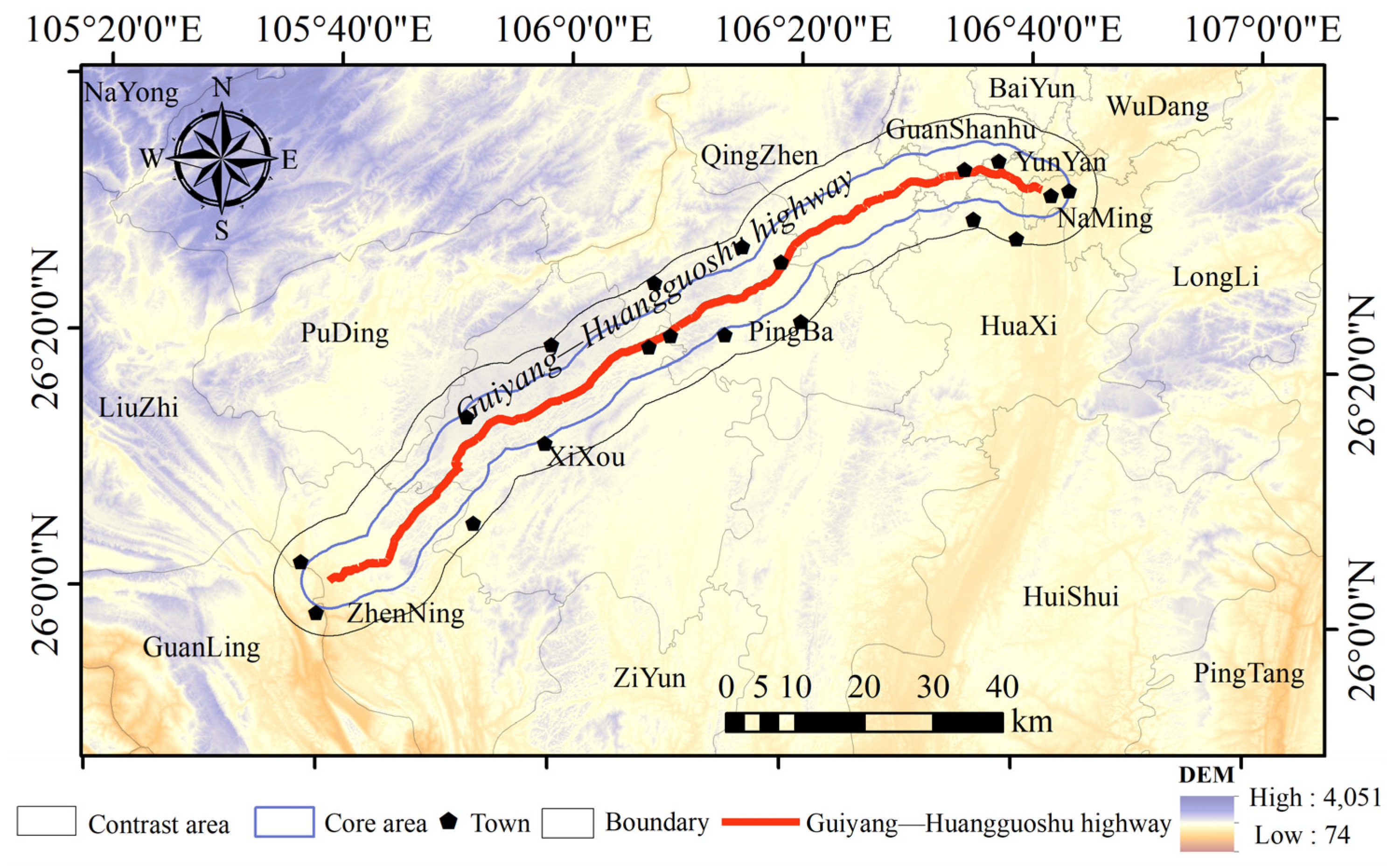
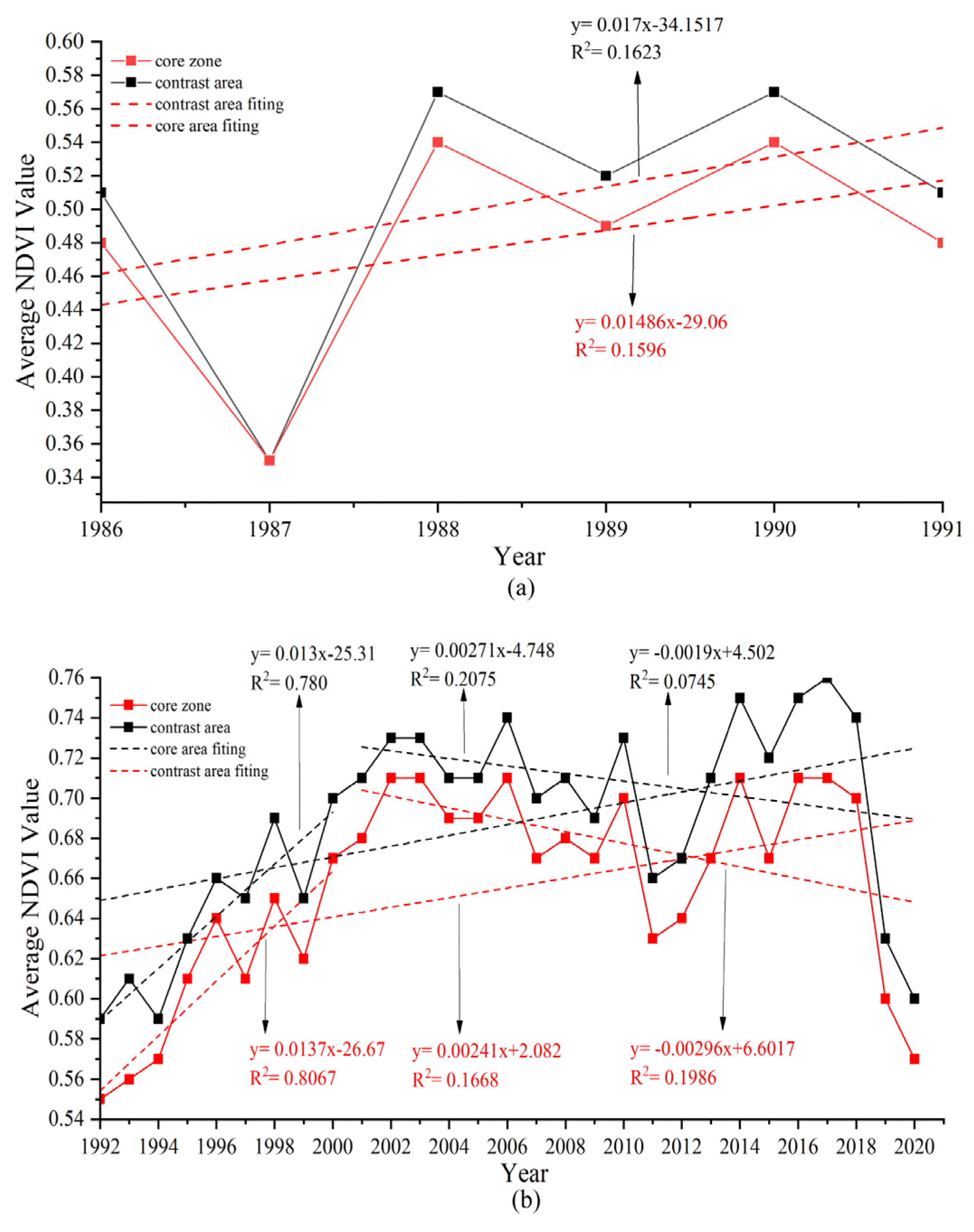
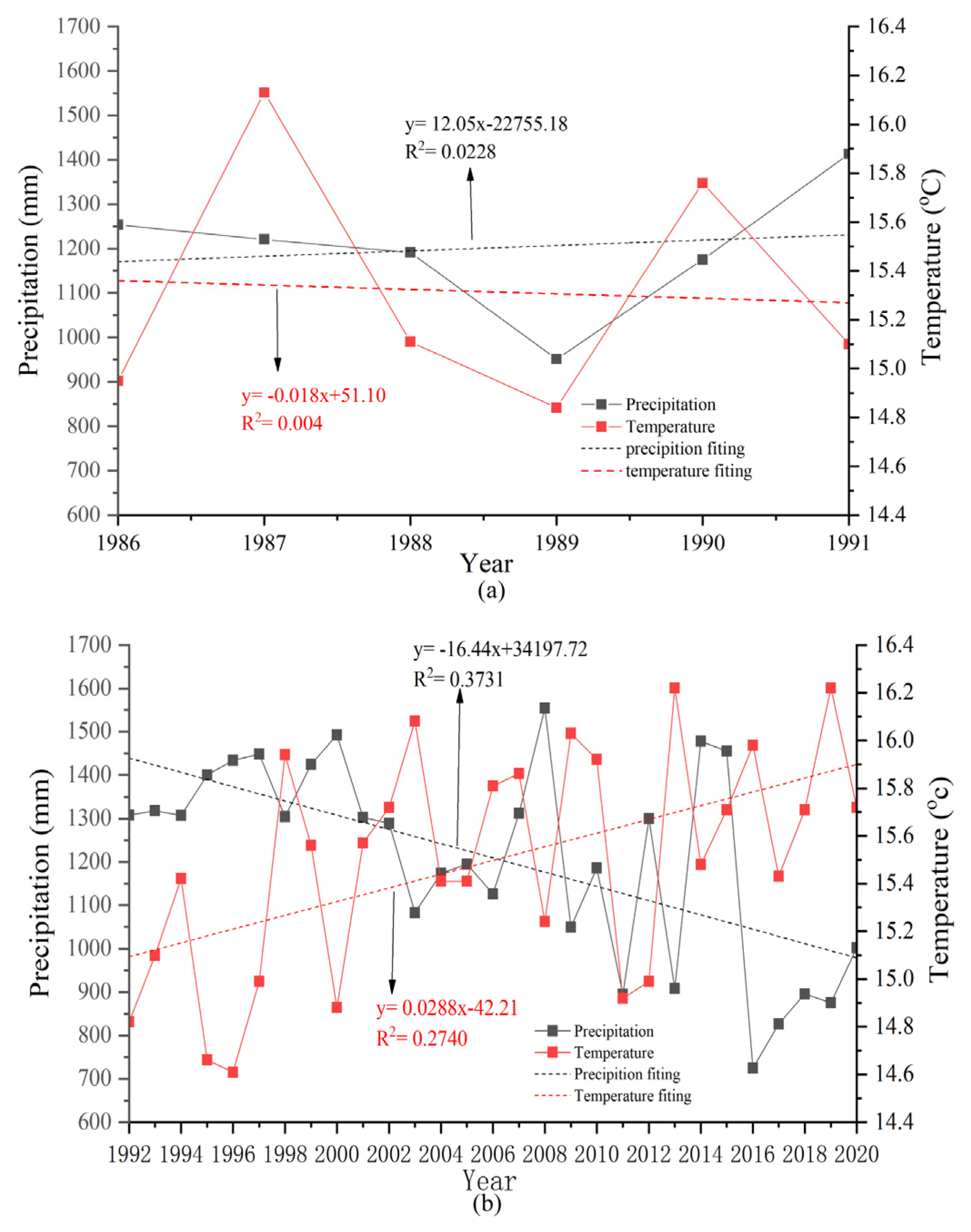

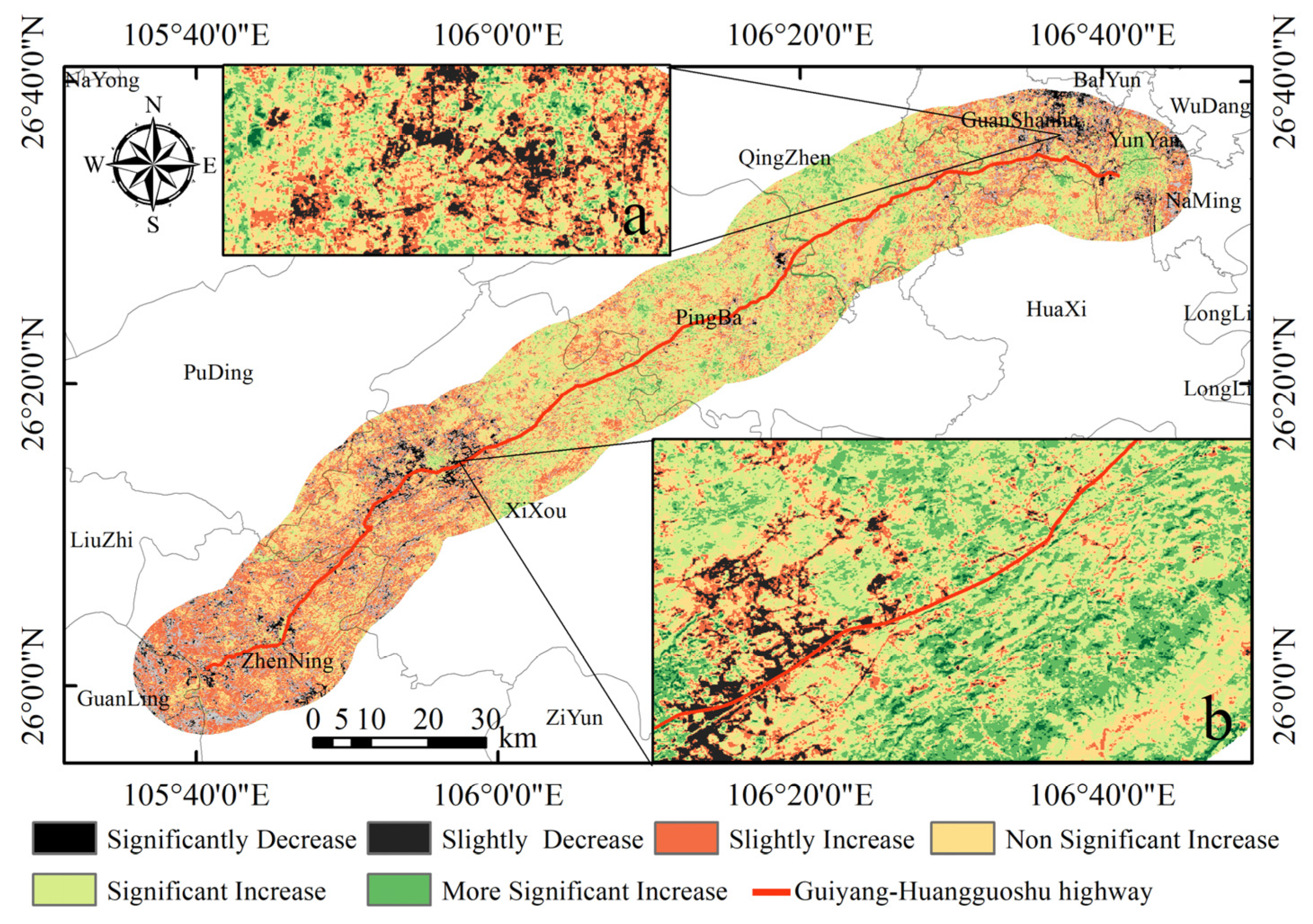
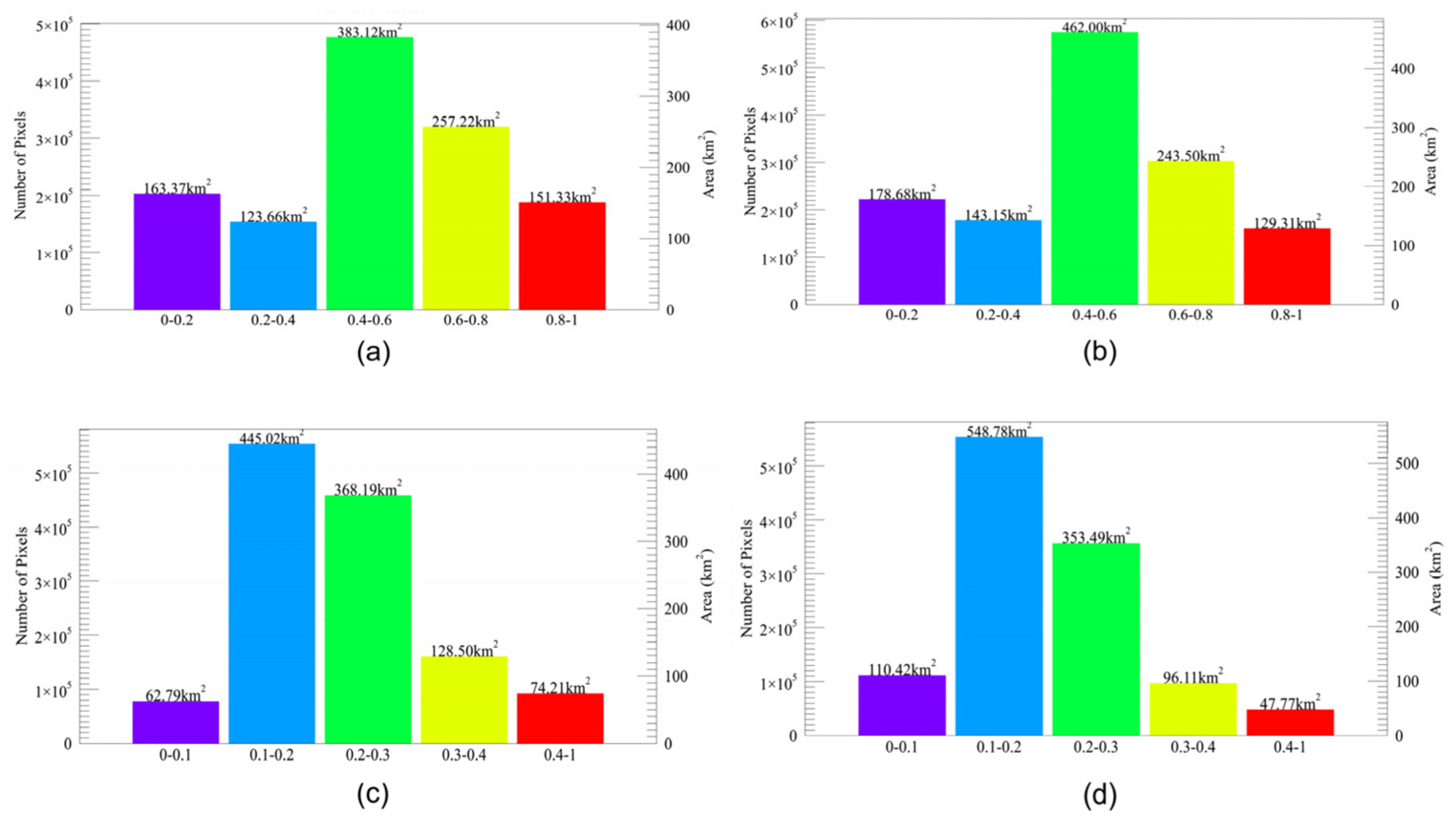

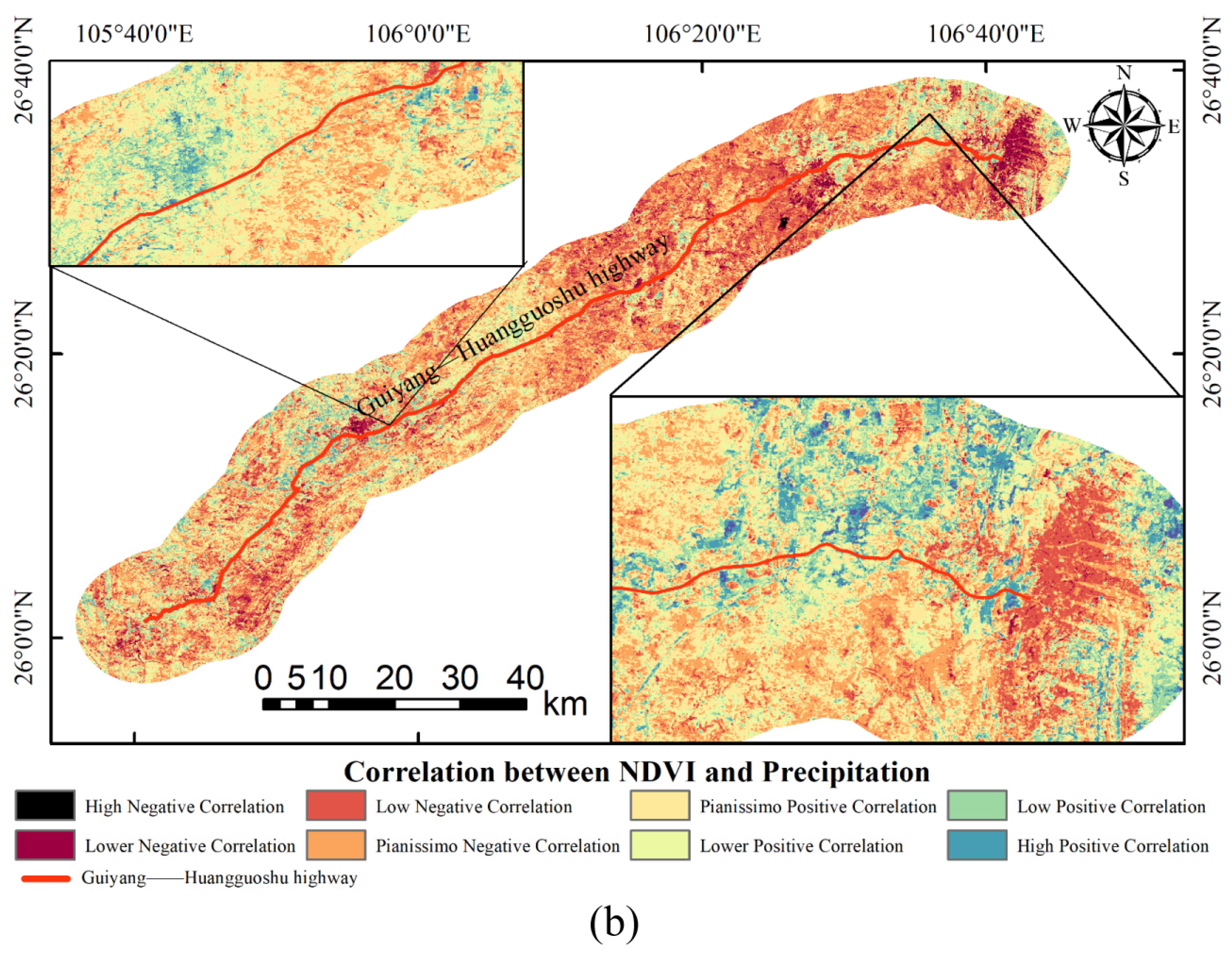
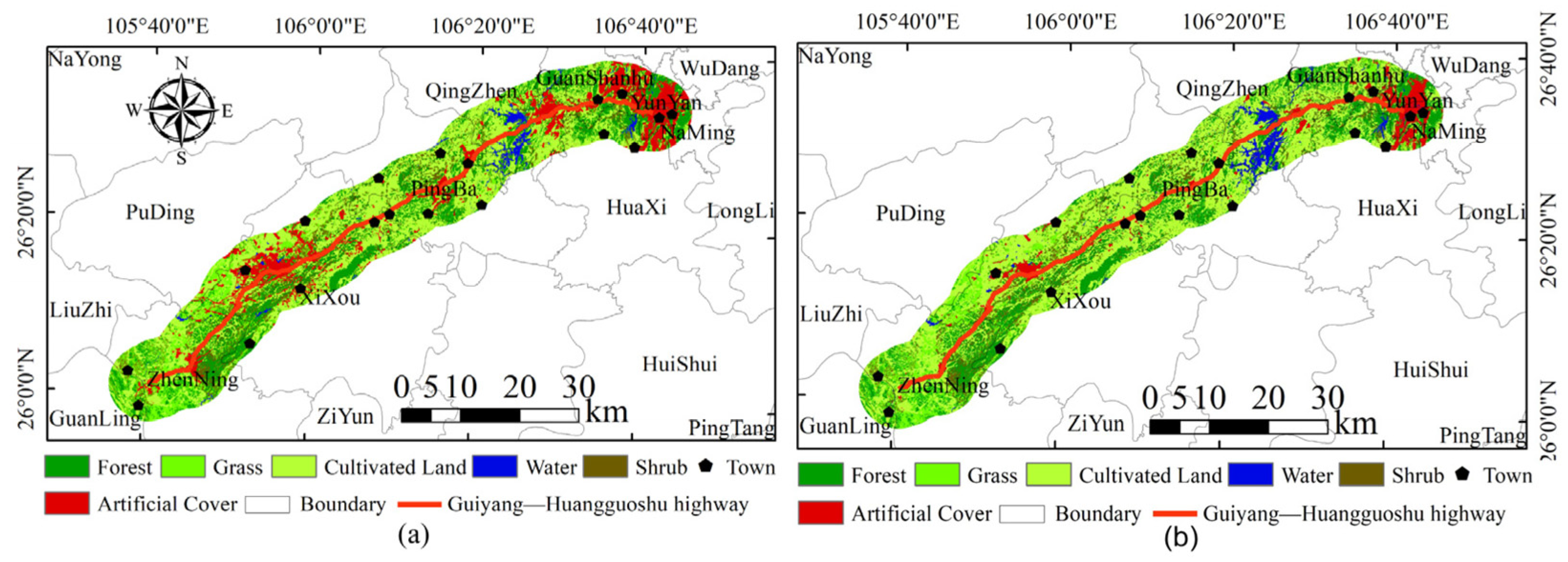
| Period | Classification | Slope | Core Area | Contrast Area | ||||
|---|---|---|---|---|---|---|---|---|
| Pixels | Area (km2) | Percent | Pixels | Area (km2) | Percent | |||
| Construction Period | Significantly Decrease | <−0.05 | 17526 | 14.08 | 0.17% | 16562 | 13.31 | 0.13% |
| Slightly Decrease | −0.05–0 | 219687 | 176.55 | 2.10% | 204681 | 164.49 | 1.65% | |
| Slightly Increase | 0–0.05 | 9691449 | 7788.51 | 92.42% | 11551849 | 9283.62 | 92.99% | |
| Significant Increase | 0.05–0.1 | 429426 | 345.11 | 4.10% | 498663 | 400.75 | 4.01% | |
| More Significantly Increase | >0.1 | 127995 | 102.86 | 1.22% | 151227 | 121.53 | 1.22% | |
| Operation Period | Significantly Decrease | <−0.01 | 9413 | 7.56 | 0.09% | 4997 | 4.02 | 0.04% |
| Slightly Decrease | −0.01–0 | 140109 | 112.60 | 1.34% | 85721 | 68.89 | 0.69% | |
| Slightly Increase | 0–0.01 | 9867593 | 7930.07 | 94.10% | 11781944 | 9468.54 | 94.84% | |
| Significant Increase | 0.01–0.02 | 464370 | 373.19 | 4.43% | 544514 | 437.60 | 4.38% | |
| More Significantly Increase | <0.02 | 4622 | 3.71 | 0.04% | 5796 | 4.66 | 0.05% | |
| Classification | 2000 LUCC | 2020 LUCC | ||
|---|---|---|---|---|
| Area (km2) | Percentage | Area (km2) | Percentage | |
| Cultivated Land | 1070.71 | 45.82% | 929.61 | 39.78% |
| Forest | 510.85 | 21.86% | 501.75 | 21.47% |
| Grass | 338.67 | 14.49% | 316.02 | 13.52% |
| Shrub | 225.15 | 9.64% | 214.16 | 9.16% |
| Water | 64.46 | 2.76% | 46.10 | 1.97% |
| Artificial Cover | 126.94 | 5.43% | 329.41 | 14.10% |
Publisher’s Note: MDPI stays neutral with regard to jurisdictional claims in published maps and institutional affiliations. |
© 2022 by the authors. Licensee MDPI, Basel, Switzerland. This article is an open access article distributed under the terms and conditions of the Creative Commons Attribution (CC BY) license (https://creativecommons.org/licenses/by/4.0/).
Share and Cite
Wu, Y.; Gu, L.; Li, S.; Guo, C.; Yang, X.; Xu, Y.; Yue, F.; Peng, H.; Chen, Y.; Yang, J.; et al. Responses of NDVI to Climate Change and LUCC along Large-Scale Transportation Projects in Fragile Karst Areas, SW China. Land 2022, 11, 1771. https://doi.org/10.3390/land11101771
Wu Y, Gu L, Li S, Guo C, Yang X, Xu Y, Yue F, Peng H, Chen Y, Yang J, et al. Responses of NDVI to Climate Change and LUCC along Large-Scale Transportation Projects in Fragile Karst Areas, SW China. Land. 2022; 11(10):1771. https://doi.org/10.3390/land11101771
Chicago/Turabian StyleWu, Yangyang, Lei Gu, Siliang Li, Chunzi Guo, Xiaodong Yang, Yue Xu, Fujun Yue, Haijun Peng, Yinchuan Chen, Jinli Yang, and et al. 2022. "Responses of NDVI to Climate Change and LUCC along Large-Scale Transportation Projects in Fragile Karst Areas, SW China" Land 11, no. 10: 1771. https://doi.org/10.3390/land11101771
APA StyleWu, Y., Gu, L., Li, S., Guo, C., Yang, X., Xu, Y., Yue, F., Peng, H., Chen, Y., Yang, J., Shi, Z., & Luo, G. (2022). Responses of NDVI to Climate Change and LUCC along Large-Scale Transportation Projects in Fragile Karst Areas, SW China. Land, 11(10), 1771. https://doi.org/10.3390/land11101771








